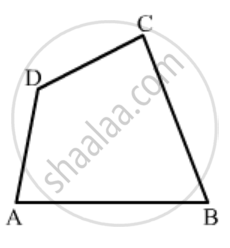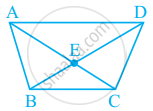Advertisements
Advertisements
प्रश्न
In Fig. 16.21, the bisectors of ∠A and ∠B meet at a point P. If ∠C = 100° and ∠D = 50°, find the measure of ∠APB.

उत्तर
\[∠A + ∠B + ∠C +∠D = 360° \]
\[ \Rightarrow ∠A +∠B + 100°+ 50° = 360° \]
\[ \Rightarrow ∠A + ∠B = 210° . . . (i)\]
\[\text{ In } \bigtriangleup APB, \text{ we have } : \]
\[\frac{1}{2}∠A + \frac{1}{2}∠B + ∠APB = 180° \]
\[ \Rightarrow ∠APB = 180° - \frac{1}{2}\left( ∠A + ∠B \right)\]
\[\text{ From (i), we get: } \]
\[ \Rightarrow ∠APB = 180° - \left( \frac{1}{2} \times 210° \right) \]
\[ \therefore ∠APB = 75° \]
APPEARS IN
संबंधित प्रश्न
In Fig. 16.19, ABCD is a quadrilateral.
Name a pair of adjacent sides.

Complete the following statement by means of one of those given in brackets against each:
If one pair of opposite sides are equal and parallel, then the figure is ........................
Complete the following statement by means of one of those given in brackets against each:
f consecutive sides of a parallelogram are equal, then it is necessarily a ..................
Which of the following quadrilateral is not a rhombus?
Two angles of a quadrilateral are 89° and 113°. If the other two angles are equal; find the equal angles.
If three angles of a quadrilateral are 90° each, show that the given quadrilateral is a rectangle.
The diagonals of a rhombus are 6 .cm and 8 cm. State the angle at which these diagonals intersect.
ΔPQR and ΔSQR are on the same base QR with P and S on opposite sides of line QR, such that area of ΔPQR is equal to the area of ΔSQR. Show that QR bisects PS.
If one angle of a cyclic quadrilateral is 75°, then the opposite angle is
In given figure, What is AC – EC?
